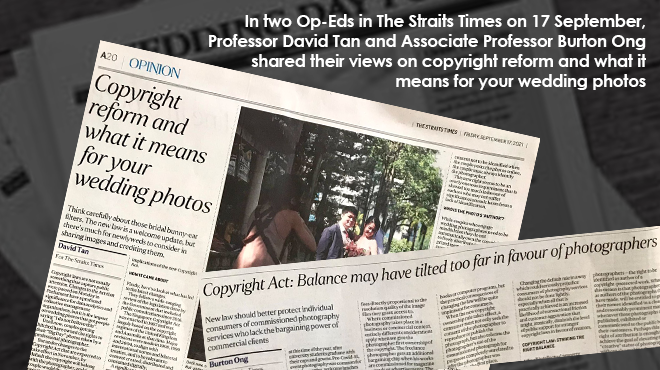Media - News
- Media
- In two Op-Eds in The Straits Times on 17 September, Professor David Tan and Associate Professor Burton Ong shared their views on copyright reform and what it means for your wedding photos
In two Op-Eds in The Straits Times on 17 September, Professor David Tan and Associate Professor Burton Ong shared their views on copyright reform and what it means for your wedding photos

The impending passage of the new Copyright Act has generated much public concern over how wedding couples may post their photographs online and make copies for distribution to family and friends.
In two Op-Eds in The Straits Times on 17 September, Professor David Tan and Associate Professor Burton Ong shared their views on these reforms.
In the main Op-Ed, “Copyright reform and what it means for your wedding photos”, Professor David Tan, Head (Intellectual Property) at EW Barker Centre for Law & Business, explains the operation of the new fair use provision, the impact of the right to be identified (also known as the moral right of attribution), and the ambiguity surrounding the definition of an author of a photograph. He concludes that the detailed public consultation exercise over a number of years by IPOS and the Ministry of Law is nonetheless an admirable effort, considering how many copyright law reform reports in places like Australia and Hong Kong have failed to make substantial legislative headway: “Indeed this is a laudable victory – but it does fall short of a home run.”
In his Op-Ed, “Copyright Act: Balance may have tilted too far in favour of photographers”, Associate Professor Burton Ong, Head (Competition Law) at EW Barker Centre for Law & Business, is of the view that the new Copyright Act should better protect individual consumers of commissioned photography services who lack the bargaining power of commercial clients. He comments that “giving the photographer first copyright ownership of all these photographic images seems inconsistent with our intuitive expectations of privacy and fairness, especially since the commissioned photographer is already being compensated for his services and can already exercise control over the individual consumer’s access to these images.”

